Does massage help fibromyalgia: with bonus self help advice
Clinical trials have shown that massage is effective in relieving fibromyalgia. However, the results show that some are better than... Read Article
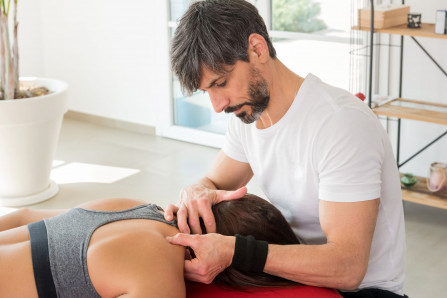
Muscle knots are a very common problem, and are usually involved in most cases of musculoskeletal pain such as back, neck or shoulder pain. In this guide we will show you three different therapies you can do yourself which work as well, if not better that the professional therapies
If you’ve had muscle knots for some time you will understand that professional therapies including needles, lasers, massage and various medications are expensive and usually just give temporary relief, so we will also share with you some excellent strategies to stop them coming back, and better still help prevent them in the first place.
What are muscle knots
Your home therapy options
How to stop your muscle knots coming back
How to prevent muscle knots
Advice for specific conditions (eg. back pain)
Of course muscle knots are not actually knots. They are part of the muscle that has spasmed or cramped forming a lump. Their technical name is (myofascial) trigger points. For more complete information please see our article Your Complete Guide To (Myofascial) Trigger Points , but here we will give you a quick summary of:
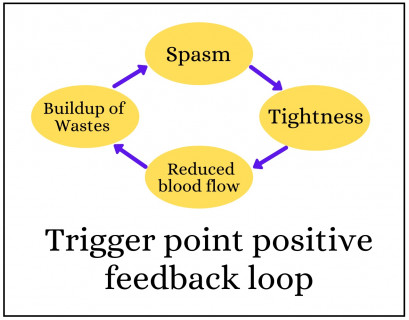
As mentioned, the lumps are part of the muscle that has gone into spasm or cramped. When it does this it tightens the muscle, pressing on the soft walled blood vessels, restricting blood flow. As shown in this diagram, this causes a build up of waste products which tends to increase the spasm. This forms what is known as a positive feedback loop, which means once muscle knots get started they tend to “feed themselves” and grow.
We have read articles saying that muscle knots involve inflammation and adhesions. This is usually wrong, so of course leads to totally inappropriate advice.
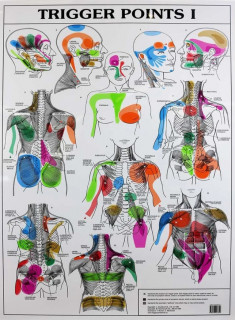
The main symptom of muscle knots is muscular tightness and pain. Scientists have mapped where each of these send pain to and have produced charts like these. As you can see they are able to cause pain in most areas of your body. Because the muscles are tight with reduced blood flow tiredness and easy fatigue are common. They can also cause a host of seemingly unrelated problems. For more details please see this this article.
Muscle knots are identified by examining the muscle, looking for the characteristic tightness with a tender lump that shoots pain when you press on it. They do not show up in any standard medical scans or laboratory tests. What that means is a professional who deals with muscle knots (eg. massage therapists, chiropactors or physios) will find and identify them in about two seconds, whereas a medical doctor will usually not find them. Of course in the next section we will show you how to easily find them yourself.
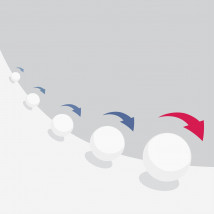
Muscle knots start small and gradually grow. As discussed above they keep growing because the muscle spasm tightens the muscle restricting blood flow causing a build up of waste products, but as we discuss in the section on prevention below most people do things to help them along as well. Because of this muscle knots usually gradually grow like snowballs rolling down a hill.
At the start you will not know the knots are there unless someone presses on them. However, once a muscle knot is large enough it can can take very little to aggravate it so it shoots pain. What this means is you may have muscle knots and not know it, then something very small or trivial can start pain such as back pain.
Muscle knots can also stop shooting pain. It is quite common to have muscle knots that shoot pain if you do something such as exercise, then settle down once rested. In this case the pain comes and goes, but the muscle knots are always there.
The same thing can happen when muscle knots are treated. The treatment stops the pain, but the knots are still there so they are eventually re-aggravated and the pain comes back again .
Understanding this the strategy we will cover includes:
In this section we will show you how to to treat muscle knots yourself. We will start with how to find them, then three effective home therapies. Standard disclaimer: this is general information only, to be discussed with a professional familiar with your needs.
How to find muscle knots
Technique one: pressure release
Technique two: pressure with massage
Technique three: vibration massage (Recommended)
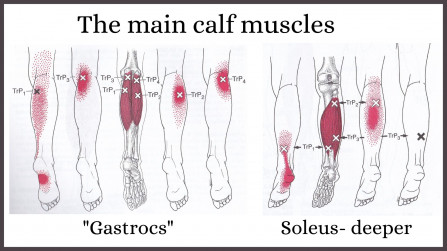
We have linked articles below covering many areas of your body and common problems. These articles have specific instructions and diagrams like this example. Alternatively, you may ask a professional for advice.
You can use the following technique to find most of your muscle knots.
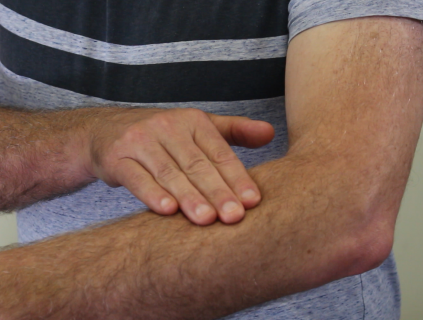
Start by using the pads of several fingers to generally examine your muscles looking for areas of tenderness and tightness.
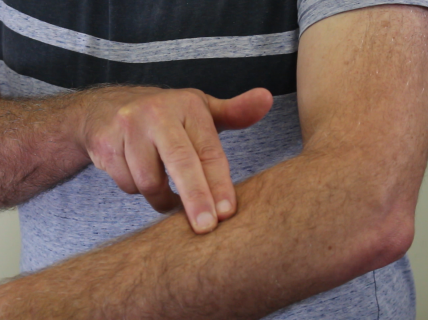
When an area of tightness or tenderness is found use one or two fingers to examine more deeply. Looking for tightness, tenderness and lumps. Generally you will find tight bands of muscle, and if you explore along these bands you will find localized areas of tightness centred around lump. Those lumps are the muscle knots. When pressed upon these will be very tender and often cause pain elsewhere.
This technique simply involves temporarily applying pressure to the muscle knots. These techniques are very commonly used, and vary from moderate pressure to therapists who use extremely painful pressure and hold until it fades. The good news is that clinical trials have shown the moderate pressure techniques to be very effective. For this guide I’ll show you two techniques: one you can use for muscles you can easily reach with your own hands, and another technique for where you need to use a mechanical tool to apply pressure.
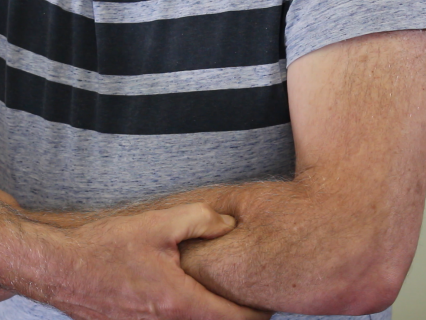
Use this technique for muscle knots you can easily reach and apply pressure with using your own hands. For this technique find the muscle knot, then apply moderate pressure until you feel the pain fade and the muscle relax, or to a maximum of 90 seconds.
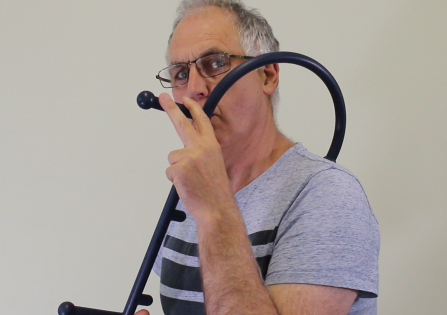
For muscle knots you cannot reach with your hands you can use a tool such as the trigger point cane shown to apply pressure. You are able to apply a lot more damaging pressure using a tool, so to keep you safe yet get great results we recommend you use a traditional Thai self massage technique. This has used very successfully in a clinical trial, giving great results . For each muscle knot use the tool to apply moderate pressure for 10 seconds then release. This is repeated five times.
For reasons discussed in our article Can foam roller be harmful we recommend you don’t apply this pressure with rollers or balls. In summary, it’s not very effective and potentially dangerous.
This technique is more effective because it adds massage which helps circulate fresh blood to help flush the wastes. However, you can only use it of parts of your body you can easily reach with your hands.
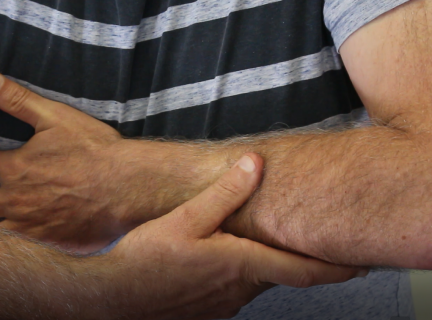
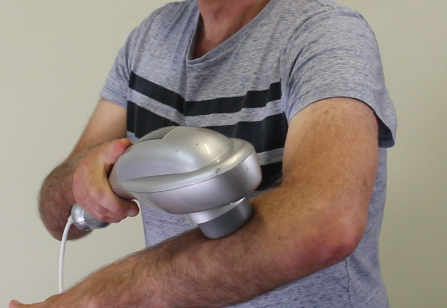
This is by far the easiest, safest and most effective of the home techniques, but you need a proper vibration massager. We’ve got a separate vibration massage usage guide that gives full details, but simply speaking all you need to do is sit the head of the massager over the trigger point and let the vibrations penetrate. Properly designed vibration massagers have ergonomically designed handles to allow you reach and apply this therapy anywhere on your body.
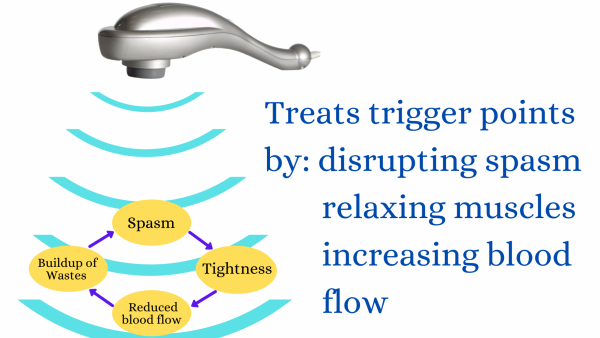
Looking back at how trigger points form we see that it involves spasm, reduced blood flow and a build up of toxic wastes basically going around in circles feeding on each other. Scientists have found that vibrations help each of these issues, so the vibrations from the massager will gradually “dissolve” the trigger points.
Vibration massage is by far the easiest and most effective therapy but you will need a proper vibration massager. As discussed in our guide Why most massagers are a waste of money , most of the vibrating massagers you can buy are not suitable.
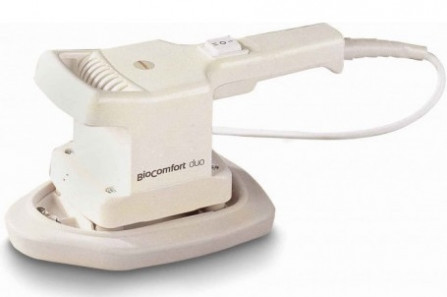
As this example of a professional vibration massager shows, vibration massagers have a head or pad that sits on the surface and sends in therapeutic vibrations. These penetrate like ultrasound (vibrations at a different frequency), and are at the correct frequency for the therapeutic effects. If you use one you will feel the vibrations going "right through you" and having a relaxing effect on your muscles. You will need a personal use version.
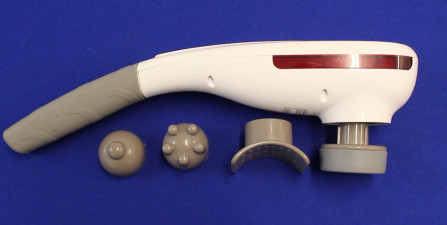
Most vibrating massagers built for consumer use are built to look good on shop shelves rather than be serious therapeutic devices. These usually have low powered motors and inadequate mechanisms, so are not capable of delivering adequate vibration.
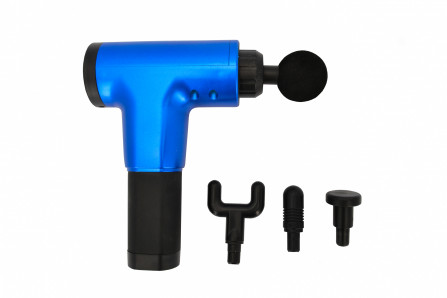
Rather than having a pad that sits on the surface and sending in vibrations massage guns are designed to drive their heads in like jackhammers. Because of this they:
When we were looking for a suitable vibration massager for our patients to use all the effective machines seemed to be "professional" products for therapists to use. These were expensive and not designed for self use. Because of this we built our own that pack the effectiveness of a professional unit into an economical one for self use. They are now used, recommended and sold by over a thousand clinics across half the world (some examples). For information about these and where to get them please use these links.
The General Purpose Massager
The Ultimate Quad Head Massager
Read what professionals say about DrGraeme massagers
The main reason pain keeps coming back after therapy or a course of treatment is that all these usually do is temporarily stop them hurting. As well, most people keep doing the things that cause the knots to develop. In this section we will show you how to use therapy to eliminate the knots rather than just relieve the pain. In the next section we will discuss things you can do to stop them developing.
As discussed in our article Why do trigger points keep coming back , most therapies merely stop the pain but do not remove the muscle knot. It feels like the problem is fixed, but of course it is still there.
Repeated therapies over time will reduce the size of muscle knots and eventually eliminate them. To do this though means continuing regular therapies for long after the pain has gone. If using professional therapies this would be prohibitively expensive, but is easily achieved using home the home therapies.
The simple strategy to eliminate muscle knots is to use the home therapies above to first stop the pain, then continue regular applications until you cannot find them when doing an examination (ie. no tightness or tender lump). After that use less frequent but regular home therapy to prevent the muscle knots from re-forming.
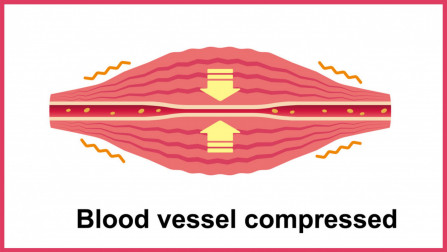
There are many causes of muscle knots including injury, muscle overload and emotional stress. However, the biggest cause is where muscle tightness restricts blood blood flow creating an environment of accumulated wastes and reduced nutrients in your muscles. This is why muscle knots are so common where postural issues (eg. sitting at a computer) or repetitive activities cause muscle tightness. It is also important to note that psychological and emotional issues can cause your muscle to tense, restricting blood flow and causing muscle knots to develop. Here are some basic ways you can help stop muscle knots from forming.
We have used the common example of sitting at a desk. However, there are may other activities that could cause issues. Our government worksafe has this excellent practical reference that covers most situations, including how to set up your chair and desk.
If you are in a situation such as sitting at a desk where your muscles may tighten take regular breaks, doing some light stretches or exercises.
Likely you will be able to reduce the amount of muscle knots that form but not stop them completely. Regular massages or the regular use of any of the the techniques above will help find muscle knots and take care of them while they are small.
Is these issues are causing you to tighten your muscles a lot seek some professional help on how to deal with them.
You should be able to use the basic examination and therapy techniques shown for most muscles of your body. To help further we’ve done articles showing specific techniques for many areas of your body. Remember: (myofascial) trigger points is the technical name for muscle knots.
Self massage and trigger point therapy for headaches and migraines
Massage and trigger point therapy for low back pains with self help options
Massage and trigger point therapy for calf pain, with self help options
Massage and trigger point therapy for shoulder pain with self help options
Self massage and trigger point therapy for tennis elbow
Does massage help with fibromyalgia, with self help advice
We are continually adding more information on research and uses. Subscribe below to have us email them to you "hot off the press".

Several years ago Dr Graeme, a Chiropractor practicing in Victoria, Australia was looking for a serious hand held massager his patients could use at home to get the extra quality massage they needed. The ones he found in the shops and on-line for home use looked nice but were not serious, and... read more
Clinical trials have shown that massage is effective in relieving fibromyalgia. However, the results show that some are better than... Read Article
Although often described as “misaligned vertebrae” or “bones out of place” most issues that cause back pain actually involve abnormal... Read Article
A gimmick is something that is not of real value used to attract attention, usually to get you to buy something. Massager guns certainly... Read Article
Do not refresh or leave this page until loading complete.